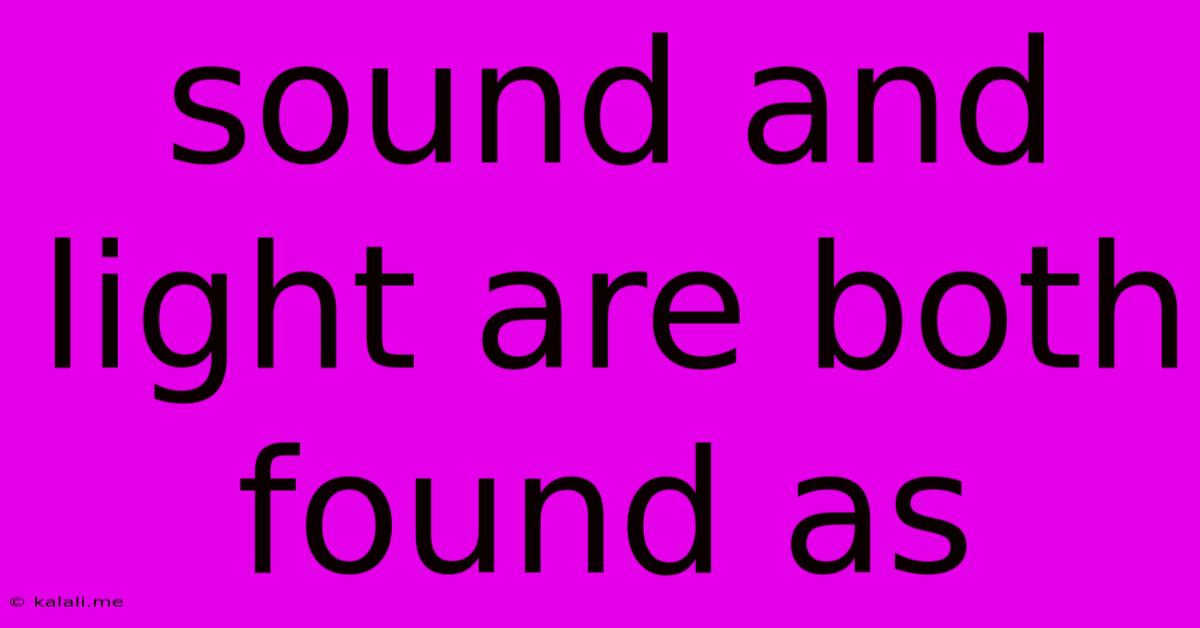Sound And Light Are Both Found As
Kalali
Jun 14, 2025 · 4 min read

Table of Contents
Sound and Light: Both Found as Waves and Particles
Sound and light, seemingly disparate phenomena, share a fascinating characteristic: they exhibit a dual nature, behaving as both waves and particles. This wave-particle duality is a cornerstone of quantum mechanics, a field that revolutionized our understanding of the universe at the atomic and subatomic levels. This article delves into the wave and particle properties of sound and light, exploring their similarities and differences.
Understanding Wave-Particle Duality
The concept of wave-particle duality suggests that entities at the quantum level can exhibit properties of both waves and particles depending on how they are observed and measured. This isn't a case of something being either a wave or a particle, but rather possessing characteristics of both simultaneously. While this might seem counterintuitive from our everyday experiences, it's a fundamental aspect of the quantum world.
Sound as a Wave
Sound, classically understood, is a mechanical wave. It requires a medium (like air, water, or solids) to propagate. The vibration of an object, such as a vocal cord or a guitar string, creates pressure disturbances that travel through the medium as longitudinal waves. This means the particles in the medium vibrate parallel to the direction of the wave's propagation. Key characteristics of sound waves include:
- Frequency: Determines the pitch of the sound. Higher frequency means higher pitch.
- Amplitude: Determines the loudness of the sound. Higher amplitude means louder sound.
- Wavelength: The distance between successive crests or troughs of the wave.
- Speed: The speed at which the wave travels through the medium.
Sound as a Particle (Phonons)
While the wave model suffices for most purposes, a more nuanced description involves phonons. In the quantum mechanical framework, sound can be viewed as a stream of quantized vibrational energy packets called phonons. These phonons behave like particles, although their behavior is still governed by wave principles. This particle-like description is particularly relevant in solid-state physics and materials science where understanding the vibrational properties of lattices is critical.
Light as a Wave
Light, unlike sound, is an electromagnetic wave. It doesn't require a medium to propagate; it can travel through a vacuum. Light waves are transverse waves, meaning the particles in the electromagnetic field oscillate perpendicular to the direction of wave propagation. Key properties of light waves include:
- Frequency: Determines the color of light. Higher frequency means higher energy and shorter wavelengths (e.g., blue light).
- Wavelength: The distance between successive crests or troughs of the wave. Visible light has wavelengths ranging from approximately 400 nm (violet) to 700 nm (red).
- Amplitude: Determines the intensity or brightness of light.
- Speed: The speed of light in a vacuum is a constant (approximately 3 x 10^8 m/s).
Light as a Particle (Photons)
The particle-like nature of light is described by photons. Photons are massless particles that carry electromagnetic energy. The energy of a photon is directly proportional to its frequency (E = hf, where E is energy, h is Planck's constant, and f is frequency). The photoelectric effect, where light shining on a metal surface ejects electrons, provides compelling experimental evidence for the particle nature of light. Photons are fundamental particles in the Standard Model of particle physics.
Similarities and Differences
Both sound and light exhibit wave-particle duality, but they differ significantly in their nature and properties:
| Feature | Sound | Light |
|---|---|---|
| Nature | Mechanical wave | Electromagnetic wave |
| Medium | Requires a medium | Does not require a medium |
| Speed | Depends on the medium | Constant in a vacuum |
| Particle | Phonon | Photon |
| Observable Effects | Pitch, loudness | Color, brightness, photoelectric effect |
Conclusion:
The wave-particle duality of sound and light highlights the limitations of classical physics and the remarkable strangeness of the quantum world. While sound and light differ greatly in their physical origins and propagation mechanisms, their shared duality underscores the fundamental interconnectedness of seemingly disparate phenomena at the quantum level. Understanding this duality is crucial for advancements in various fields, from acoustics and optics to materials science and quantum computing.
Latest Posts
Latest Posts
-
According To Machiavelli The Ideal Form Of Government Was
Jun 14, 2025
-
Average Act Score For University Of Minnesota
Jun 14, 2025
-
If A Waves Frequency Doubles Its Wavelength
Jun 14, 2025
-
New Mexico State University Admission Requirements
Jun 14, 2025
-
What Is Not Required For Photosynthesis
Jun 14, 2025
Related Post
Thank you for visiting our website which covers about Sound And Light Are Both Found As . We hope the information provided has been useful to you. Feel free to contact us if you have any questions or need further assistance. See you next time and don't miss to bookmark.